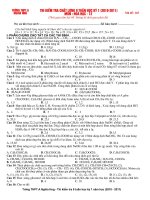Đáp án Tín hiệu và hệ thống kì 1 năm học 2016-2017 - UET - Tài liệu VNU
Bạn đang xem bản rút gọn của tài liệu. Xem và tải ngay bản đầy đủ của tài liệu tại đây (238.57 KB, 3 trang )
<span class='text_page_counter'>(1)</span><div class='page_container' data-page=1>
VIETNAM NATIONAL UNIVERSITY, HANOI
<b>University of Engineering and Technology</b>
<i>Date: June 17, 2016</i>
<b>FINAL EXAMINATION - ANSWERS</b>
<b>Course: Signals and Systems (ELT2035)</b>
Duration: 90 minutes
<i><b>Part 1 (Multiple-choice questions): For problems in this part, you only have to</b></i>
<i>give the letter of the correct answer (A/B/C/D). Explanations are not required.</i>
<b>Problem 1. (1 point) Which one of the systems described by the following </b>
input-output relations is a stable linear time-invariant system?
<i>A. y (t)=2 x(t )sin (3 π t)</i>
<i>B. y (n)− y (n−1)=2 x(n)</i>
<i>C. y (t)=2x(t)u(t−1)</i>
<i>D. y (n)=2 x (n)+ x (n−1)</i>
<i>Answer: D</i>
<b>Problem 2. (1 point) A continuous-time linear time-invariant system is described</b>
by the following transfer function:
<i>H ( s)= 2 s−1</i>
<i>s</i>2+<i>s−2</i>
Among the following statements about the given system, which one is TRUE?
A. The system can be both causal and stable.
B. The system can be both anti-causal and stable.
C. If the system is causal, then it is not stable.
D. If the system is stable, then it is neither causal nor anti-causal.
<i>Answer: D</i>
<b>Problem 3. (1 point) Which one of the following signals is NOT an energy signal?</b>
<i>A. x (t)=e</i>−2 t +1<i><sub>u(t−1)</sub></i>
<i>B. x (n)=2</i>−|<i>n|</i>
<i>C. x (t)=[cos(π t/ 2+π /4)]</i>−1[<i>u(t)−u(t−10)]</i>
<i>Page 1/3</i>
</div>
<span class='text_page_counter'>(2)</span><div class='page_container' data-page=2>
<i>D. x (n)=[cos (π n/2+π/ 4)]</i>−1[<i>u(n)−u(n−10)]</i>
<i>Answer: C</i>
<b>Problem 4. Given the following discrete-time periodic signal:</b>
<i>x (n)=ej π n/2</i><sub>+cos(π n/3+π/4)+2 sin (π n/ 4)+1</sub>
What is the fundamental period of the given signal?
<i>A. T</i>0=6 (samples)
<i>B. T</i>0=12 (samples)
<i>C. T</i>0=18 (samples)
<i>D. T</i>0=24 (samples)
<i>Answer: D</i>
<i><b>Part 2 (Exercises):For problems in this part, detailed explanations/derivations</b></i>
<i>that lead to the answer must be provided.</i>
<b>Problem 5. (3 points) Given a continuous-time causal linear time-invariant system</b>
described by the following differential equation:
<i>d</i>2<i>y(t)</i>
<i>dt</i>2 +
<i>dy (t)</i>
<i>dt</i> +
<i>y(t )</i>
2 =2
<i>dx (t)</i>
<i>dt</i> +<i>x (t)</i>
a) Is the given system stable or not?
<i>Answer: Stable, because all system roots lie in the left half of the </i>
<i>s-plane.</i>
b) Determine the system impulse response.
<i>Answer:</i>
<i>H ( s)=</i> <i>2 s+1</i>
(
<i>s+1− j</i>2
)(
<i>s+</i><i>1+ j</i>
2
)
= 1
<i>s+1− j</i>
2
+ 1
<i>s+1+ j</i>
2
<i>h(t )=(e</i>−
<i>1− j</i>
2 <i>t</i><sub>+e</sub>−
<i>1+ j</i>
2 <i>t</i><sub>)</sub><i><sub>u(t)</sub></i>
<i>c) Determine the system response to the input x (t)=e</i>−t /2<i><sub>u(t) .</sub></i>
<i>Answer:</i>
<i>X (s)=</i> 1
<i>s+1/2</i>
<i>Page 2/3</i>
</div>
<span class='text_page_counter'>(3)</span><div class='page_container' data-page=3>
<i>Y ( s)=</i> <i>2 s+1</i>
(
<i>s+1− j</i>2
)(
<i>s+</i><i>1+ j</i>
2
)
1
<i>s+1/2</i>=
2
(
<i>s+1− j</i>2
)(
<i>s+</i><i>1+ j</i>
2
)
<i>y (t)=2[− je</i>−
<i>1− j</i>
2 <i>t</i><sub>+</sub> <i><sub>je</sub></i>−
<i>1+ j</i>
2 <i>t</i><sub>]</sub><i><sub>u(t)</sub></i>
<b>Problem 6. (3 points) Given a discrete-time linear time-invariant system having</b>
<i>the impulse response h(n)=2</i>−n<i>u(n−1) .</i>
a) Determine the system frequency response.
<i>Answer:</i>
<i>H (Ω)=</i> <i>e</i>
−<i>j Ω</i>
<i>2−e</i>−<i>j Ω</i>
b) Determine the system response to the input signal
<i>x (n)=sin (π n/ 2+π /3)+2 cos(π n)+3 .</i>
<i>Answer:</i>
<i>y (n)= 1</i>
<i>2 j</i> <i>H (π/2)e</i>
<i>j(πn /2+ π/3)</i>
− 1
<i>2 j</i> <i>H (−π/2)e</i>
−<i>j( πn /2 +π/3)</i>
+<i>H (π)ej π n</i>+<i>H (−π)e</i>−<i>j π n</i>
+<i>3 H (0)</i>
c) Determine the system response to the input signal
<i>x (n)=3n</i><sub>[</sub><i><sub>u(n)−u(n−10)] .</sub></i>
<i>Answer:</i>
<i>y (n)=x (n)∗h(n)=</i>
∑
<i>k =0</i>
9
3<i>k</i>2−(n−k)<i>u(n−k −1)</i>
<i>If n<10 then y (n)=</i>
∑
<i>k=0</i>
<i>n−1</i>
3<i>k</i>2−(n−k) <i>...</i>
<i>If n>=10 then y (n)=</i>
∑
<i>k=0</i>
9
3<i>k</i>2−(n−k) <i>...</i>
***** END *****
<i>Page 3/3</i>
</div>
<!--links-->









